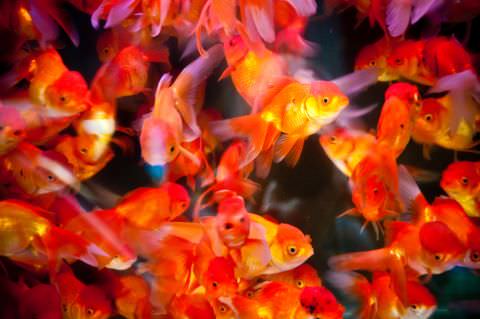| Back to Back Issues Page |
 |
|
The Goldfish Gazette, Issue #123 Feeding Juveniles March 31, 2024 |
Goldfish Care TipsA Free Monthly Resource For Goldfish Enthusiasts In This Issue To take advantage of the accelerated growth rate of Goldfish in their first year of life, feeding should be frequent and heavy. Feeding Juveniles
Fry should be at this stage of development 4 weeks after becoming free swimming and have a body length of 16mm (5/8”). This size is for fancy varieties, single tailed varieties will be longer. If you have sourced small fish from a pet store, you can safely assume they are juvenile fish if purchased in late spring early summer. Juveniles usually take until the next season to become adults, but some males can start showing breeding tubercles as early as 6 months old. Heavy feeding is only one factor that is necessary to grow juveniles fast. Others include: Water TemperatureThe speed Goldfish process food depends on water temperature. When temperatures rise above 20oC (68oF), there is a noticeable increase in appetite. Keep water temperatures around 25oC (77oF) if possible.Water QualityWith heavy feeding comes heavy waste production. A good filtration system will stop any ammonia outbreaks, but nitrates soon build up surprisingly quickly.Another important consideration is crowding. Whether it is growth inhibiting hormones or pheromones, crowded Goldfish will not grow no matter how much they are fed or filtered. Some breeders will change water daily to maintain water free of these chemicals. What Foods to FeedJuveniles require a high protein diet. Foods with a protein value of around 40% are good, but live foods are best.Live foods such as daphnia, mosquito larvae and bloodworms will live until eaten so can be fed in large amounts; just be careful with daphnia as they do compete for oxygen with the fish. Mosquito larvae being air breathers are the ideal live food. Dry foods are much harder to feed heavily as they tend to dissolve before the fish can eat them, hence the requirement to feed small amounts frequently throughout the day. Gel foods are a good compromise between live and dry foods as the gelatin holds the food together longer. How Much to FeedThe feeding of juveniles is completely different to feeding adults. 2% of body weight daily is fine for adult fish, but juveniles can eat 15% of their body weight daily easily.This is the advantage of feeding live foods, you don’t have to worry about how much to feed. The fish just gorge themselves, have a short rest while digesting their initial feast, then resume feeding at a slower rate. The best indication of whether you are feeding enough is to look down on top of the juveniles after feeding. Their bellies should stick out further than their gill plates. Many pet stores feed very little if anything to their fish for various reasons such as maintaining water quality. If you want to put some size on these fish quickly, gradually increase the amount of food over two weeks to allow their digestive systems to adapt to their new food, new environment and larger food volume. It also gives the filter time to adapt to the higher bio-load the extra feeding brings. Comments? Ideas? Feedback? I'd love to hear from you. Just reply to this e-zine and tell me what you think, or what topics you want to be covered. Next Month's Topic Care Comparison by Varietywww.facebook.com/aboutgoldfish |
| Back to Back Issues Page |
